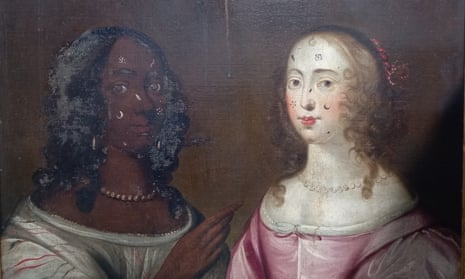A painting has been saved for the UK in recognition of its “outstanding significance” for the study of race and gender in 17th-century Britain, it will be announced on Friday.
The anonymous artist’s portrait of two women – one black and one white, depicted as companions and equals with similar dress, hair and jewellery – has been bought by Compton Verney, an award-winning gallery in Warwickshire.
Titled Allegorical Painting of Two Ladies, the work, part of the English school dating to about 1650, appears to be a moralising picture, criticising the use of cosmetics in altering a person’s natural appearance.
Their faces are covered in curious beauty patches that were fashionable at the time and which the painting’s inscription condemns as a sin of pride, a widespread opinion in the 17th century.
Wearers of such patches or spots – made of silk or velvet – risked provoking the wrath of God. Part of the purpose of the patches was to hide imperfections or signs of disease. The white sitter wears black patches of various shapes and the black sitter has white ones.
The painting was at risk of permanently leaving the UK after being auctioned in Shropshire in 2021. A temporary stop to allow a UK institution to acquire it was placed by the Reviewing Committee on the Export of Works of Art and Objects of Cultural Interest.
The independent body, serviced by Arts Council England (ACE), advises the secretary of state for Digital, Culture, Media and Sport on whether a cultural object intended for export is of national importance under specified criteria.
Noting that its departure from the UK would be a “misfortune”, the committee’s report stated: “The depiction of a black female sitter in a 1650s painting was highly unusual … inviting important debate about race and gender during the period.”
It added: “It visualises in a way that no other painting of the period does the early modern debates concerning the morality of cosmetics use; discourses on ideal beauty and blackness; issues concerning gender hierarchy and female agency; as well as attitudes to race and ethnicity, especially so in an age that witnessed increasing global contact through trade and colonial expansion.”
An unidentified owner had intended to take the painting overseas unless a UK buyer could be found.
The picture, an oil on canvas measuring 640 x 750mm, was unknown to scholars until it surfaced at auction from the estate of the sixth Lord Kenyon. It had an initial valuation of between £2,000 and £4,000, but it sparked such intense interest that it sold for £220,000.
Now it has been acquired by Compton Verney for more than £300,000, with £154,600 from the National Heritage Memorial Fund (NHMF) and £50,000 from the ACE/V&A Purchase Grant Fund. Compton Verney covered the rest through an acquisition fund established by the sale of a painting several years ago.
after newsletter promotion
Two Ladies will now undergo conservation and extensive study to understand its complex narrative by the Yale Centre for British Art at Yale University, before going on public display next year.
Compton Verney is based in a Grade I-listed Georgian mansion within 120 acres of parkland designed by the 18th-century landscape architect Lancelot ‘Capability’ Brown. With its permanent collections, it is an accredited museum and registered charity.
Geraldine Collinge, its CEO, said: “The painting fits so interestingly with our collections. We’ve got portraits and folk art, where we’re thinking about different ways of showing people. For us, it opens up a conversation about who’s in portraits and why certain people aren’t in portraits.”
She added: “We don’t know who the women were. The fact that it’s two women – one is black, one is white – is particularly interesting for us now and they were stories that were deliberately not told.”
